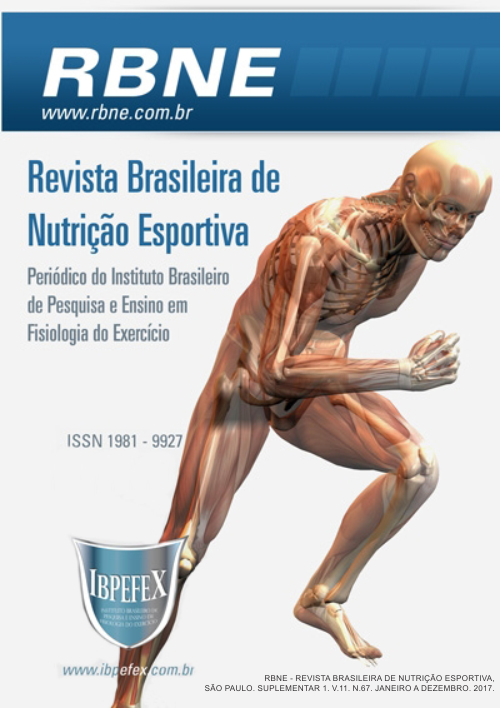Whey Protein as an alternative protein supplement for lactose intolerant individuals
Abstract
Introduction: Whey protein are extracted during the cheese-making process and have high nutritional value. Essential amino acid content, especially branched chain proteins, makes whey proteins widely used by practitioners of physical activity at all levels. However, because it is a protein supplement of milk source, it is necessary to know the lactose content present in the supplement. Aim: To analyze the lactose content in whey protein supplement to verify if the product is an alternative protein supplement for lactose intolerant individuals. Materials and methods: Eight Brazilian brands of the whey protein supplement purchased in Caxias do Sul were analyzed. The analysis was carried out in the Faculdade Fátima Science Laboratory and followed the methodology described by the Adolfo Lutz Institute. Results: The analysis showed that the brands contained lactose levels between 0.13 g.100 mL-1 and 0.27 g.100 mL-1. The average content of lactose was less than 0.5 g.100 mL-1 in all samples. As for the energetic value from proteins, two samples contained below the recommended value, which is at least 50%. Relative to the energetic value from proteins, two samples contained below the recommended value, which is at least 50%. Conclusion: Were found of lactose content values below 0.5 g.100 mL-1, suggesting that the supplements evaluated can be considered as food for special needs regarding to their consumption by patients with intolerance to disaccharide (lactose) intake.
References
-Brasil. Agência Nacional de Vigilância Sanitária (ANVISA).Resolução RDC n. 18, de 27 de abril de 2010. Aprova o Regulamento Técnico sobre Alimentos para Atletas. Brasília, Diário Oficial da União, 28/04/2010. 2010. Disponível em: <http://portal.anvisa.gov.br/documents/33916/394219/RDC%2B18_2010.pdf/d6815465-e99a-477f-bb35-48b1432b380e>.
-Brasil. Agência Nacional de Vigilância Sanitária. ANVISA. Resolução RDC nº 360, de 23 de dezembro de 2003. Regulamento Técnico sobre Rotulagem Nutricional de Alimentos Embalados. 2003. Disponível em: <http://anvisa.gov.br/alimentos/legis/especifica/rotuali.htm>.
-Brasil. Código de Proteção e Defesa do Consumidor. Lei 8.078, de 11 de setembro de 1990. Dispõe sobre a proteção do consumidor e dá outras providências. 1990. Disponível em <http://www.planalto.gov.br/ccivil_03/LEIS/L8078.htm>.
-Brasil. Lei nº 13.305, de4 de julho de 2016. Acrescenta art. 19-A ao Decreto-Lei nº 986, de 21 de outubro de 1969, que “institui normas básicas sobre alimentos”, para dispor sobre a rotulagem de alimentos que contenham lactose. Brasília, Diário Oficial da União, 05/07/2016. 2016. Disponível em: <http://www.planalto.gov.br/CCIVIL_03/_Ato2015-2018/2016/Lei/L13305.htm>.
-Brasil. Portaria nº 29, de 13 de janeiro de 1998. Secretária de Vigilância Sanitária, do Ministério da Saúde, (Versão Republicada -30.03.1998). Aprova o Regulamento Técnico referente a Alimentos para Fins Especiais. Publicada em Diário Oficial da União; Poder Executivo, de 30 de março de 1998. 1998. Disponível em: <http://www.anvisa.gov.br/anvisalegis/portarias/index98.htm>.
-Conselho Federal de Nutricionistas. CFN. Resolução n° 334, de 10 de maio de 2004. Dispõe sobre o Código de Ética do Nutricionista e dá outras providências. Brasília, Diário Oficial da União, 15/05/2004. 2004. Disponível em: <http://www.crn2.org.br/crn2/conteudo/Codigo_de_etica1423071576.pdf>.
-Conselho Federal de Nutricionistas. CFN. Resolução n° 380, de 9 de dezembro de 2005. Dispõe sobre a definição das áreas de atuação do nutricionista e suas atribuições, estabelece parâmetros numéricos de referência, por área de atuação, e dá outras providências. Brasília, Diário Oficial da União, 10/01/2006. 2006a. Disponível em: <http://www.cfn.org.br/novosite/pdf/res/2005/res380.pdf>.
-Conselho Federal de Nutricionistas. CFN. Resolução n° 390, de 21 de fevereiro de 2006. Regulamenta a prescrição dietética de suplementos nutricionais pelo nutricionista e dá outras providências. Brasília, Diário Oficial da União, 22/01/2006, Seção I. 2006b. Disponível em: <http://www.cfn.org.br/novosite/pdf/res/2006/res390.pdf>.
-Haraguchi F.K.; Abreu W.C.; de Paula H. Proteínas do soro leite, suas propriedades funcionais: principais benefícios para a saúde. Rev. Nutr. Vol. 2. Num. 4. p. 479-488. 2008.
-INMETRO. Ministério do Desenvolvimento, Indústria e Comércio Exterior Instituto Nacional de Metrologia, Qualidade e Tecnologia. Programa de análise de produtos: Relatório final sobre a análise em suplementos proteicos para atletas. Rio de Janeiro, 13 de maio de 2014. Divisão de Orientação e Incentivo à Qualidade -Diviq Diretoria de Avaliação da Conformidade -Dconf Inmetro. Disponível em: . Acessado em 27/10/2016.
-Instituto Adolfo Lutz (São Paulo). Métodos físico-químicos para análise de alimentos /coordenadores Odair Zenebon, Neus Sadocco Pascuet e Paulo Tiglea. São Paulo: Instituto Adolfo Lutz, 2008. p. 1020.
Authors who publish in this journal agree to the following terms:
- Authors retain the copyright and grant the journal the right of first publication, with work simultaneously licensed under the Creative Commons Attribution License BY-NC which allows the sharing of the work with acknowledgment of the authorship of the work and initial publication in this journal.
- Authors are authorized to enter into additional contracts separately for non-exclusive distribution of the version of the work published in this journal (eg, publishing in institutional repository or book chapter), with acknowledgment of authorship and initial publication in this journal.
- Authors are allowed and encouraged to post and distribute their work online (eg, in institutional repositories or on their personal page) at any point before or during the editorial process, as this can bring about productive change as well as increase impact and impact. citation of published work (See The Effect of Free Access).






